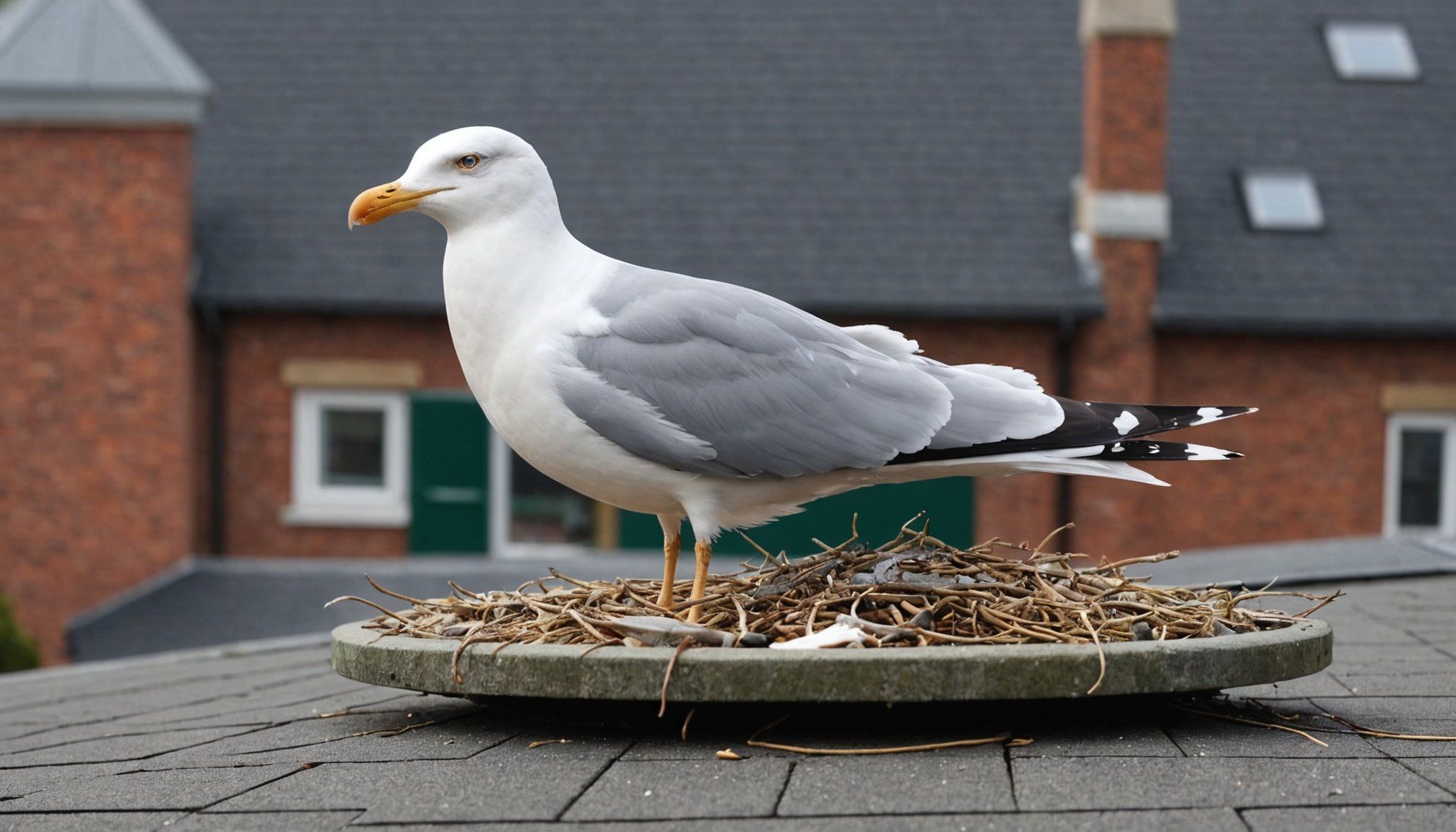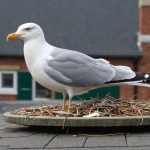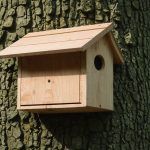Understanding the Problem of Urban Seagulls
Urban seagulls have adapted to city life, thriving in environments filled with man-made structures. These birds often choose rooftops and ledges as their preferred nesting sites. A significant reason for this choice is the minimal number of predators and easy access to food sources such as discarded waste.
The impact of urban seagulls extends beyond their nesting habits. Seagulls often cause damage to residential and commercial properties. Their acidic droppings can erode building materials and their loud calls are a frequent noise complaint. Additionally, seagulls can be aggressive, especially during nesting season. They sometimes swoop down on people they perceive as threats, particularly around their nests, posing risks to both pedestrians and property owners.
Sujet a lire : Top Enrichment Ideas to Keep Your Domestic Ferrets Engaged and Boredom-Free
Given these challenges, addressing seagull nesting issues promptly is crucial. Early intervention can help mitigate damage and minimize interruptions to daily life. Effective pest management strategies focus on discouraging nesting by altering habitats in ways that make them less attractive to seagulls. Proactive measures, such as installing spikes or securing waste, can reduce seagull populations and their impact on urban environments. Therefore, awareness and timely action are key in controlling the urban seagull problem.
Humane Deterrent Methods
Introducing humane bird control strategies is essential for addressing pest concerns without causing harm to animals. Among these, visual deterrents provide an effective solution. Using items like reflective surfaces, such as shiny tapes or CDs, can confuse and frighten birds, subtly encouraging them to move elsewhere. Decoys, mimicking natural predators, offer another ethical pest management option, leveraging birds’ instincts to enhance effectiveness.
Lire également : Transform your small uk backyard into a duck paradise: a comprehensive guide to crafting an inviting outdoor space for your pet duck
Sound deterrents present additional deterrent strategies. Devices that emit predator calls or distress signals can deter birds, especially seagulls. However, the key to their success lies in the variation of sounds. Constant repetition might lead to acclimation and ineffectiveness over time, requiring periodic adjustments to maintain their impact.
Motion-activated devices blend innovation with humane bird control. By detecting movement, these devices activate unexpected elements—like water sprays or mechanical falcons—that startle birds away without harm. This tactic is particularly useful in areas prone to seagull presence, where traditional methods fall short.
To summarise, integrating these deterrent strategies into a cohesive plan not only ensures ethical pest management but also maintains the balance between human activities and the surrounding ecosystem.
Environmental Modifications
Designing a space to deter seagulls requires strategic environmental design. One effective measure is ensuring that roof designs discourage nesting. Flat or gravel-covered roofs often become preferred nesting sites. Instead, opt for sloped, metal, or smooth-surface roofs that make it difficult for gulls to establish nests.
Furthermore, maintaining pristine cleanliness around property areas is crucial. Seagulls are drawn to leftover food and trash. By promptly removing waste and ensuring trash bins are securely closed, you minimize the appeal of your surroundings to these opportunistic birds. Regular cleaning schedules can also assist in keeping these areas unappealing to them.
In addition, planting native vegetation that seagulls find less appealing can be an effective deterrent. Choose flora that provides limited access to food or nesting materials. Thorny or densely packed plants can further discourage seagull settlement. Selecting vegetation that thrives in the local climate also ensures lower maintenance while enhancing the landscape naturally.
Implementing these strategies assists in creating a habitat modification that effectively minimizes seagull presence, allowing both property and local ecosystems to thrive without the adversities associated with these birds.
Legal Considerations
When tackling issues related to seagulls, it’s essential to understand the bird protection laws in place. Seagulls, like many bird species, are often protected by local regulations that restrict certain actions against them. These laws are intended to preserve wildlife and their natural habitats.
Before engaging in any removal or deterrence actions, it might be necessary to obtain proper permits. Understanding these permits ensures compliance and prevents any legal issues or penalties. In many areas, taking action without the proper authorization is considered illegal and can result in severe fines.
Seagull protection laws dictate what is considered legal or illegal, including when and how deterrence actions can be implemented. Committing any acts that harm these birds without the necessary permits can lead to significant fines or even criminal charges. This underlines the importance of adhering to local regulations and fully understanding the legal landscape before proceeding with management actions. While these laws can seem cumbersome, they are vital for maintaining ecological balance.
Case Studies of Successful Tactics
Delving into success stories and real-life examples of seagull control can illuminate effective strategies for managing these birds in urban environments. One standout example comes from a coastal city where property owners collaborated to deploy various methods. They installed anti-bird spikes and nets and coordinated feeding restrictions. This multi-faceted approach drastically reduced the gulls’ presence and disruption, setting a benchmark for others.
An analysis of the methods showed particular strategies’ strengths. Anti-bird spikes were notably effective in deterring seagulls from perching and nesting on rooftops. Nets, strategically placed over open areas, prevented gulls from gaining access. These combined actions formed a barrier without harming the birds, proving both ethical and successful.
Conversely, lessons learned from unsuccessful efforts emphasize the importance of adaptability. One community faced challenges when their methods, such as predator decoys, proved temporary. Birds quickly adapted, rendering the deterrents ineffective. This highlighted the necessity of periodic reassessment and method diversification to maintain effectiveness.
The varied strategies and their outcomes offer valuable insights into crafting a comprehensive plan suitable for different urban scenarios. Understanding past experiences equips property owners with the knowledge to navigate similar challenges with greater success.
Maintenance and Monitoring Techniques
Regular inspections and maintenance are crucial for effective pest control maintenance. By consistently assessing building structures and surrounding areas, potential seagull nesting sites can be identified early. This proactive approach aids in mitigating seagull issues before they escalate.
Implementing monitoring strategies tailored to seagull behaviour is essential for achieving long-term effectiveness. Understanding the behavioural patterns and flight paths of seagulls requires ongoing observation. As these birds adapt to environmental changes, monitoring strategies must also evolve. Adapting these strategies ensures that pest control remains effective, despite the dynamic nature of wildlife behaviour.
Utilizing technology plays a significant role in enhancing monitoring efforts. Advanced tools, such as drones and motion-activated cameras, offer real-time data on seagull activity. These technologies assist in tracking movement patterns and identifying specific times and areas of heightened activity. By integrating technology into monitoring strategies, the effectiveness of pest control measures is maximized.
In conclusion, the integration of regular inspections, adaptable strategies, and cutting-edge technology ensures robust pest control maintenance. By focusing on these elements, property managers can maintain seagull population control over the long term. Leverage these techniques to stay ahead in managing seagull-related problems effectively.











